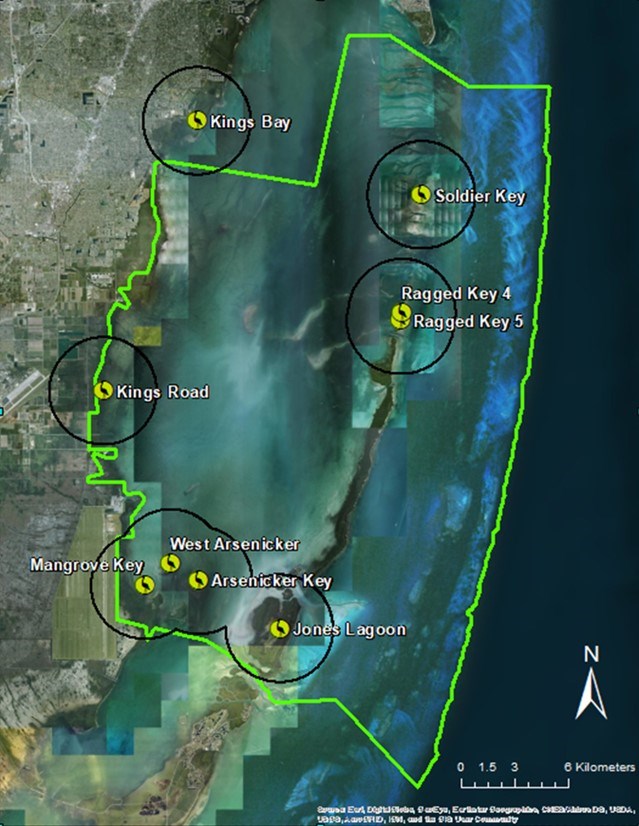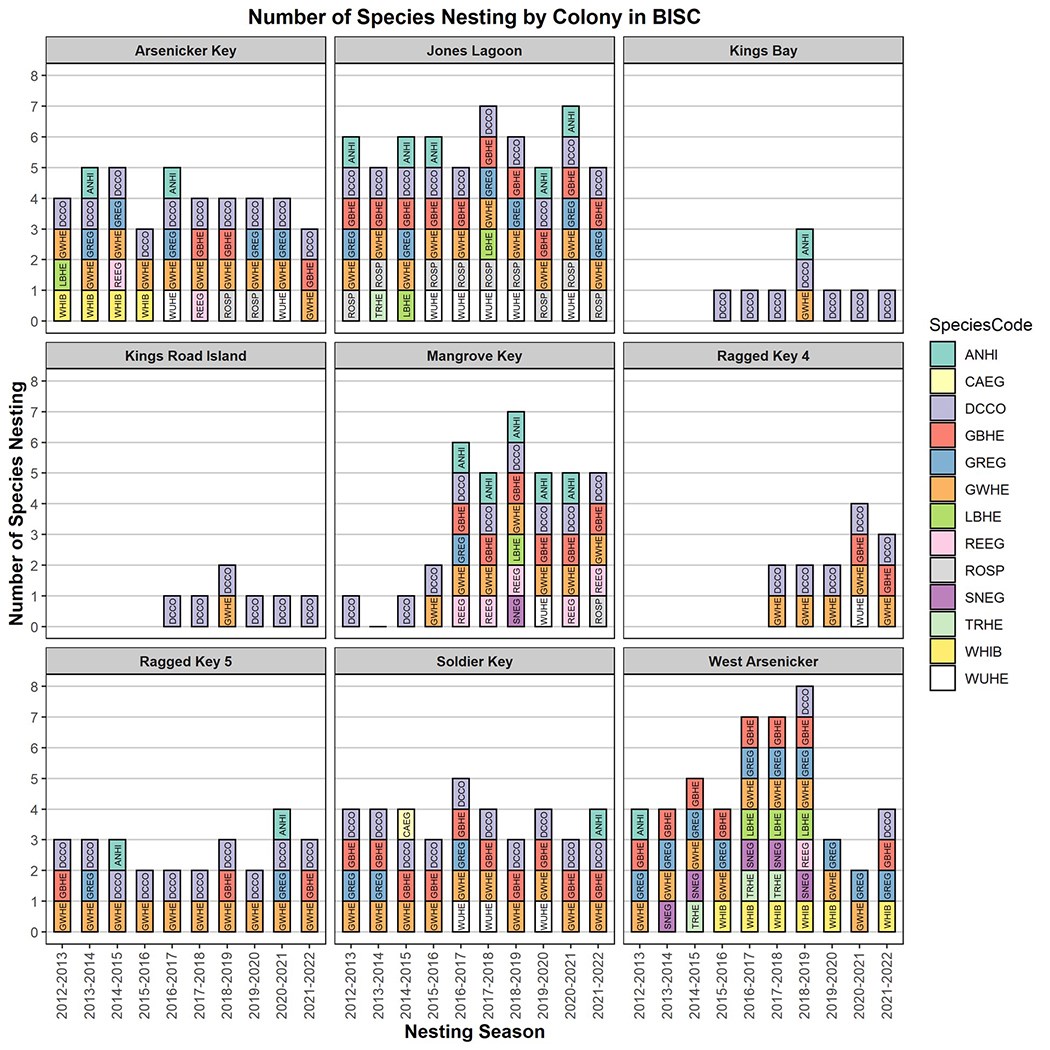Last updated: February 19, 2025
Article
Colonial Nesting Birds in Biscayne National Park: 2021-2022 Nesting Year Summary

NPS photo / SFCN staff
Overview
Biscayne National Park gets a lot of usage due to its close proximity to metropolitan area of Miami, Florida. Nesting colonies of wading birds and seabirds use the park for foraging, roosting and nesting. The birds are good indicators of ecosystem health in how they respond to changes in the quality and supply of food, possible contaminants, invasive species, and other disturbances. Selecting mates, building nests, laying eggs and rearing chicks requires lots of energy. If the habitat can't support these activities, their nesting ability suffers. The South Florida/Caribbean Inventory and Monitoring Network (SFCN) of the National Park Service annually monitors colonial nesting birds in the park, completing its 12th year of monitoring in 2021-2022.

SFCN staff
Conducting Surveys
Counts and Photos Collected via Helicopter
Monitoring is conducted via helicopter discovering new nesting colonies of wading birds and seabirds, coupled with monthly surveys of previously located colonies. Two SFCN staff members, a photographer and an observer ride in a helicopter which circles each island colony. Photographs are taken and the number of visible nesting and non-nesting birds are recorded. The photographs are uploaded to a computer and processed to identify active nests by species. The identified nests are circled on the photographs and then counted from the processed photographs.
Peak nest counts are identified for each colony and summed across colonies to calculate the peak nesting year total for each species. An annual nesting index is also calculated, which is the sum of monthly nest counts for the entire nesting year. The nesting estimates for months with no sampling are calculated as the average of the months before and after the missing month. The South Florida/Caribbean Network uses the annual nesting index along with peak nest counts because species like double-crested cormorants (Phalacrocorax auritus) nest in all months, and peak nest counts alone are not sufficient to describe the nesting effort. Estimating the true number of nest starts is not feasible.
The 2021–2022 peak nest counts and nesting index are compared to the previous nine nesting seasons’ mean, maximum and minimum. Surveys were conducted July through November 2021; and March, April, and June 2022. The nine colonies surveyed were: Kings Road Island, Mangrove Key, West Arsenicker, Arsenicker Key, Jones Lagoon, Ragged Key 4, Ragged Key 5, Soldier Key, and Kings Bay. The Kings Bay colony is north of the park boundary, but birds nesting there likely use the park for resources so covering it helps complete the picture.
The Results
Peak Nest Counts Up for White Ibis
There is a focus on six species including double-crested cormorants (Phalacrocorax auritus), great blue herons (Ardea Herodias), great egrets (Ardea alba), great white herons (Ardea herodias occidentalis), roseate spoonbills (Platalea ajaja), and white ibises (Eudocimus albus) and they are grouped by feeding method: diver, stalk and strike, and tactile feeders. Peak nest counts for white ibis increased relative to the previous nesting season. The other five focal species were lower in 2021–2022 than in 2020–2021.
Divers
For divers, double-crested cormorants nested in all nine colonies from 2021–2022. They remain the most prominent nesting bird species in the survey, as cormorant nests comprised 96% of the photographed nests of focal species and 93% of the peak nest counts for the last 10 nesting seasons. The 2021–2022 peak nest count of 736 for double-crested cormorants was lower than the 10-year average of 966 nests per year. Double-crested cormorants were the only species detected nesting on the Kings Bay and Kings Road colonies.
Stalk and Strike
For stalk and strike species, the 2021–2022 peak nest count for great blue heron was 12 and 25 for the great white heron, within their respective minimums and maximums. The peak nest count of three for the great egret equals the lowest in the last 10 seasons. The nesting index values of 35.9 for great blue herons, 43.1 for great egrets, and 134.45 for great white herons all fell within their respective minimums and maximums and were lower than last year’s values. Great blue herons were detected nesting on seven colonies, great whites on six colonies, and great egrets on two colonies. Great blue herons were detected nesting on all colonies except Kings Road and Kings Bay colonies. Great egrets were only detected on Jones Lagoon and West Arsenicker Key. The great white herons were not detected on Kings Bay, Kings Road, and West Arsenicker, but were detected at the other six sites.
Tactile Feeders
For tactile feeders, roseate spoonbills were detected nesting on Jones Lagoon and Mangrove Key, while the white ibis was only detected on West Arsenicker. Although both are tactile feeders, their nesting times are different. Roseate spoonbills nest in the dry period, while white ibis nest in the wet season.
Colonies
No new colonies were detected and all surveyed colonies maintained some level of nesting. Only Soldier Key and West Arsenicker showed increases in the number of species. Arsenicker Key, Jones Lagoon Ragged Key 4, and Ragged Key 5 showed reductions while Kings Bay, Kings Road, and Mangrove Key remained the same. For the 2021–2022 nesting season, the double-crested cormorants were the only species detected on all nine colonies. Great blue herons nested on seven colonies and great white herons on six. Only double-crested cormorants were detected on Kings Bay and Kings Road.
Helicopter problems and an administrative shutdown, canceled surveys from December 2021 through February 2022. The May 2022 survey was also canceled because of personnel and helicopter unavailability. The lack of data makes it difficult to compare annual trends.
For the 2021–2022 nesting year, nine species were photographed nesting and 17 species observed using the colonies. More species were observed than photographed nesting which suggests colonies function not only for reproduction but for roosting and refugia for the additional species.
| Common Name |
Species Code | Photographed Nests | Field Observed Birds |
|---|---|---|---|
| Anhinga | ANHI | 1 | 20 |
| Black vulture | BLVU | – | 41 |
| Brown pelican | BRPE | – | 169 |
| Double-crested cormorant | DCCO | 3,769 | 3,734 |
| Great blue heron | GBHE | 15 | 22 |
| Great egret | GREG | 5 | 83 |
| Great white heron | GWHE | 54 | 109 |
| Gulls and Terns* | LARI | – | 37 |
| Little blue heron | LBHE | – | 5 |
| Magnificent frigatebird | MAFR | – | 157 |
| Osprey | OSPR | 1 | 4 |
| Reddish egret | REEG | 1 | – |
| Roseate spoonbill | ROSP | 3 | 15 |
| Snowy egret | SNEG | – | 8 |
| Tricolored heron | TRHE | – | 10 |
| Turkey vulture | TUVU | – | 24 |
| Unidentified* | UNID | 19 | 16 |
| Unidentified Dark Bird* | UNDA | 1 | – |
| Unidentified White Bird* | UNWH | 11 | 8 |
| White ibis | WHIB | 31 | 53 |
| White-crowned pigeon | WCPI | – | 6 |
| Yellow-crowned night-heron | YCNH | – | 3 |
| Grand Total | – | 3,911 | 4,524 |

SFCN staff
Full Report
Colonial Nesting Birds in Biscayne National Park: 2021-2022 Nesting Year Summary
